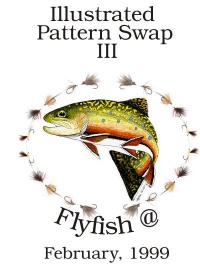The Illustrated Pattern Swap

- by Sue K.
The Illustrated Pattern Swap (IPS) seemed like a great way to unleash some
energy, creativity and involve others in the fun.
So how'd it start?
I was trading emails with two superb tyers in Europe, Hans Weilenmann (Holland)
and Martin Joergensen (Denmark). Their email descriptions of some of the
steps of tying some patterns were not clear to me. I asked if they would
resort to the (old fashioned) letter method, provide me with drawings of
what they meant by 'this step' or 'that process'. They obliged.
The illustrations were unique to these two individuals, quite different in
drawing style. I could tell they had fun doing the illustrations. Couple
this happening with the fact that I am an inveterate doodler. No artist am
I, no talent, but I love all kinds of art. I thought, why not swap ILLUSTRATED
how-to-tie fly patterns, instead of the standard swapping of tied flies?
The First Illustrated Pattern Swap , 1996-97
I proposed the idea to the FF@ members in the fall of 1996. I knew the IPS
would be at least one remedy to the upcoming winter shack-nasties for not
only myself, but everyone else.
There were 27 participants the first year. Entrants were from all over the
U.S., Canada and foreign countries as well. There was a fair amount of cajoling
that I, as swapmistress, had to do to convince participants they could DO
IT and to get their packages into Colorado where I would collate and compile.
It took four months to get it completely done and the finished products in
the hands of the participants.
The Second Annual Illustrated Pattern Swap, 1997-98
Again, it was started in Fall, we had 42 participants this year. At this
point, the guidelines for illustrations still included black and white, along
with colour, and there were no restrictions on the length of each person's
entry. Some were as short as one page, others up to 8 pages long.
IPS Swap Rules and Guidelines
For all these swaps, there were 'rules' and guidelines. For example, in the
first two, the participants could use any medium and method, but the final
product had to be in hardcopy paper format. There had to be a fly pattern
included in the description and a minimum of five illustrations.
The results run the gamut, from pen drawings, to computer-generated to
photographs, or a combination of several methods. Some were in black and
white, some in color. Some swappers chose cartoon or fictional story formats.
Each participant was required to send enough sets of their entry for all
the swappers in the swap, plus extras for giving away at conclaves and to
the FF@ listmeister, and the FF@ archivist. In addition to the narrative
and illustrations, in the first two swaps, the participants were asked to
include one tied fly for their pattern. This fly was mailed to one of the
other randomly-selected participants in the swap.
Changes in The Third Illustrated Pattern Swap, 1998-99
 The rules were changed somewhat for this third go-round.
After discussing the changes with some of the swappers, we agreed on a limit
of 3 pages, and all illustrations had to be in color. No black and white
for the 98-99 version. There were 37 participants in IPS III. The rules were changed somewhat for this third go-round.
After discussing the changes with some of the swappers, we agreed on a limit
of 3 pages, and all illustrations had to be in color. No black and white
for the 98-99 version. There were 37 participants in IPS III.
|
Website locations for IPS I through III
All three Illustrated Pattern Swaps can be viewed at Byard Miller's "Virtual
Flybox" website :
IPS I :
http://www.virtualflybox.com/ips1/ips1_intro.shtml
IPS II :
http://www.virtualflybox.com/ips2/intro.shtml
IPS III :
http://www.virtualflybox.com/ips3/ips3_intro.shtml |



 The rules were changed somewhat for this third go-round.
After discussing the changes with some of the swappers, we agreed on a limit
of 3 pages, and all illustrations had to be in color. No black and white
for the 98-99 version. There were 37 participants in IPS III.
The rules were changed somewhat for this third go-round.
After discussing the changes with some of the swappers, we agreed on a limit
of 3 pages, and all illustrations had to be in color. No black and white
for the 98-99 version. There were 37 participants in IPS III.